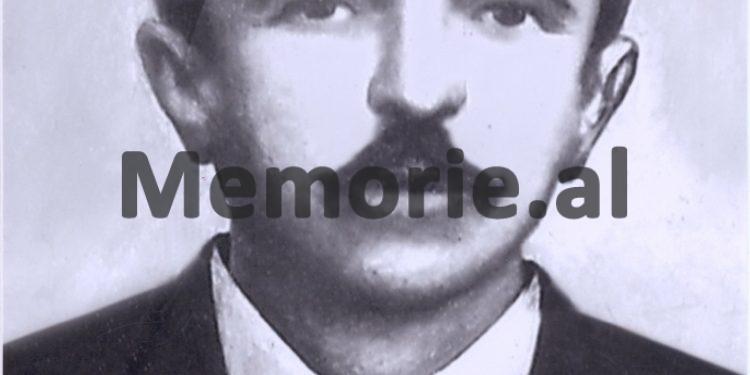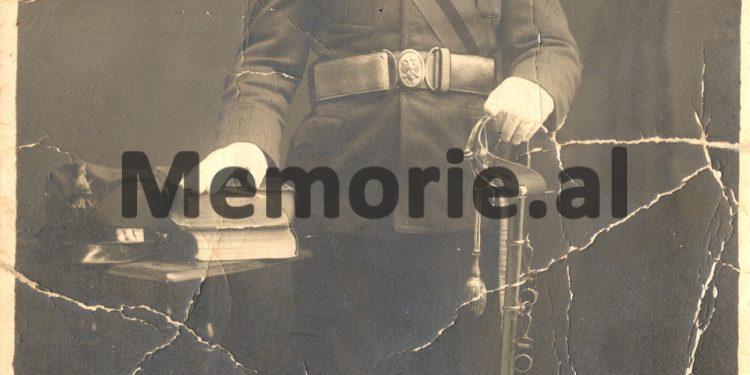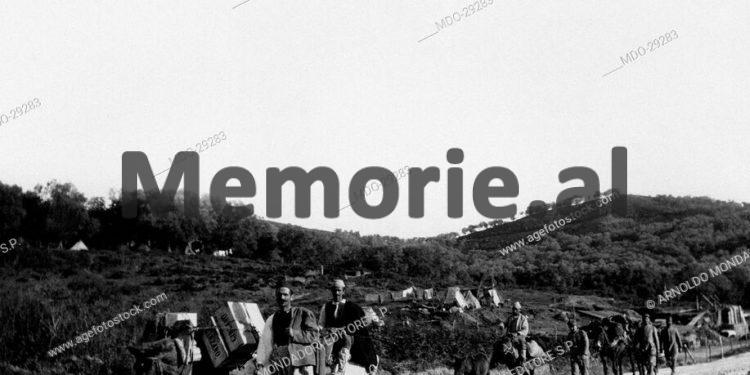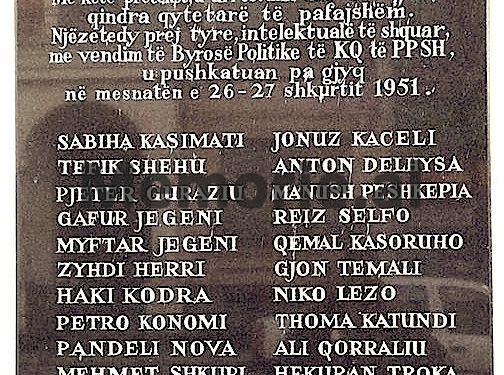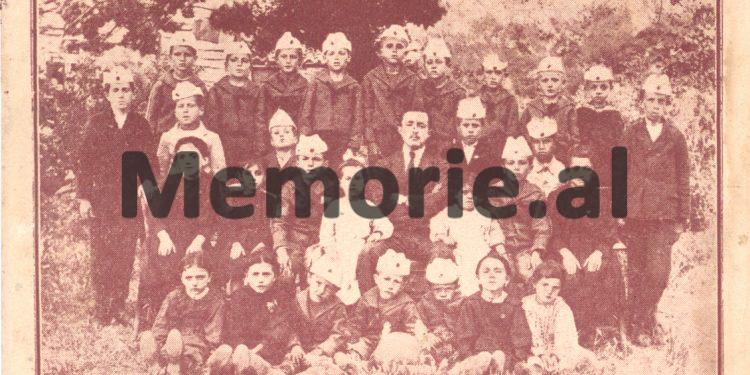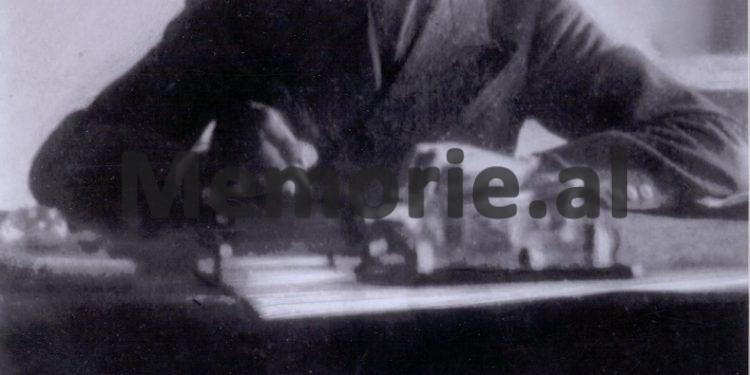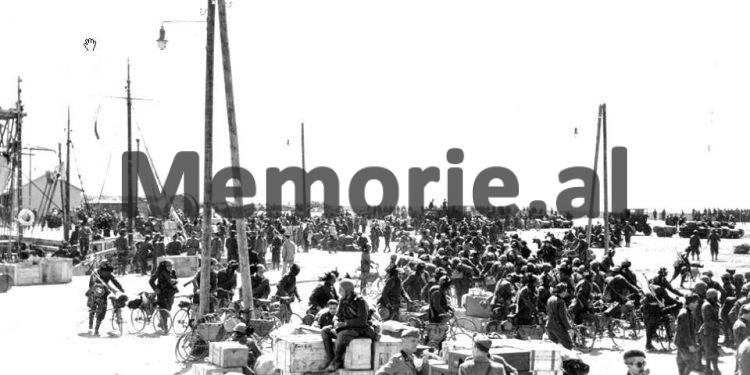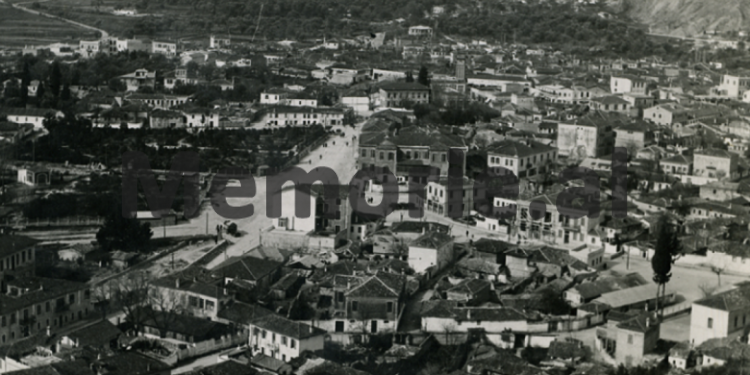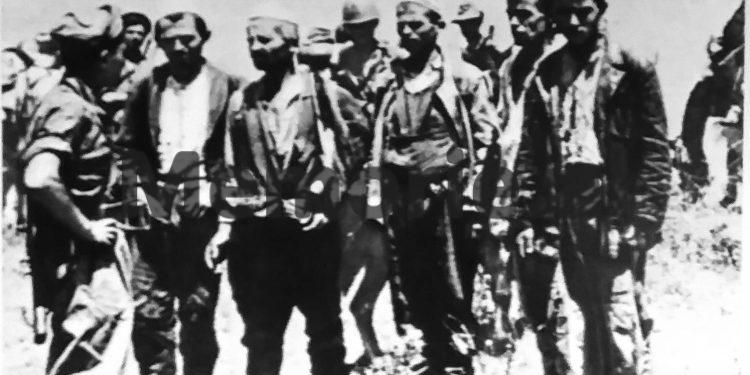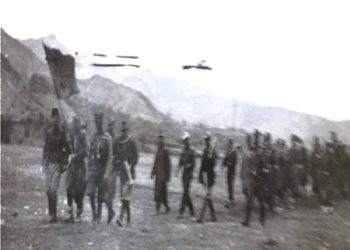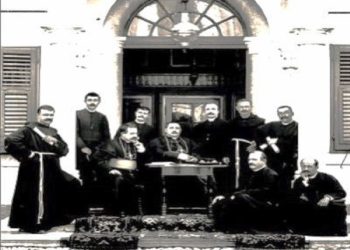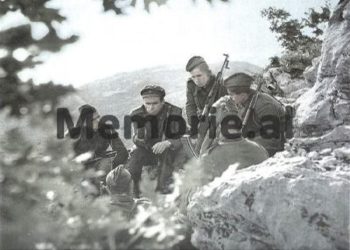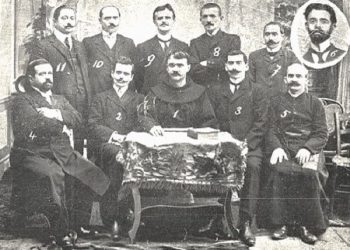Dashnor Kaloçi
Memorie.al published the unknown story of the armed resistance that took place on April 7, 1939 to the Italian military troops of the occupation in the village of Bestrovë in Vlora, where together with the volunteer forces from Vlora, some soldiers of a unit of the Kingdom of Albania fought. , commanded by Captain Gafurr Jegeni, originally from Dibra e Madhe and Mark Pjetër Doçi from Kthella of Mirdita.
Testimonies of Vlora veterans: Abaz Kallarati, Shaqo Derri, Faik Bedini, Musa Muho, etc., for Captain Gafurr Jegenin and Lieutenant Mark Pjetër Doçi, who in the first days of April 1939, organized in the city of Vlora the volunteer forces of composed of young men who armed them and on 7 April under their command put up a resistance to the Italian troops during the landing at the Bestrova pier, where many soldiers were killed.
All the details of that event that was deleted and not mentioned by the historiography of the communist regime and the tragic fate of the organizer of that armed resistance, who after suffering for four years in internment camps in the islands of Italy for the armed resistance that ‘had done to the Italians on April 7 ’39, 12 years later, was executed without trial by the communist regime of Enver Hoxha, for the bomb incident at the Soviet embassy in Tirana.
On April 7, 1939, when Benito Mussolini’s fascist Italy carried out military aggression and invaded Albania, some military units of the Kingdom of Albania, also assisted by volunteer force, made an armed resistance, nailing the Italian occupiers for several hours, as in: Durrës, Porto-Romano, Shengjin, Baçallëkut Bridge, Shkodër, Vlora, Bestrovë and Saranda. During that armed resistance, the Italian army suffered significant damage to people and military arsenal, but also from the units of the Kingdom of Albania and the volunteer forces that went to their aid, there were casualties. But all that resistance, although symbolic that was done to the Italians on April 7, 1939, as by the commander of the Durrës Gendarmerie, Major Abaz Kupi, and dozens of other soldiers of the Zog Monarchy, was left in oblivion and in the historiography of the regime. Enver Hoxha’s communist, mentions only the captain of the Royal Navy Finance Guard, Mujo Ulqinaku, who fought and fell heroically near the Tower of Durrës Castle. One of those soldiers of the Kingdom of Zog who organized the resistance against the Italian invaders in Vlora and was never mentioned during the years of the communist regime, was also Captain Gafurr Jegeni, originally from Dibra e Madhe, who was executed in 1951 being charged with the bombing incident at the Soviet embassy.
But what was Gafurr Jegen’s past, where was he educated and what military career did he have during the years of the Zog Monarchy? How did he organize the military resistance against the Italian invaders in Vlora and who were the other soldiers who fought with him? In this regard, we know the numerous testimonies of some honored veterans from Vlora, such as: Abaz Kallarati, Shaqo Derri, Musa Muho, Faik Bedini, etc., who were eyewitnesses of that event that happened that distant day in April 1939. , which was never reflected in any of the history books or the various anniversaries commemorating that symbolic resistance to the Italian invaders.
From the Italian Academy to the Border Guard
Gafurr Jegeni was born on August 15, 1910 in the city of Velika Dibra, where his family comes from. The Jegeni family was one of the most famous in that province and among the most heard men of that tribe were Tefiku, Shaqiri and Riza Jegeni, who were respected by the entire Dibra parish. Gafurri’s childhood went through the years of the First World War, where in the house of the Jegens gathered to gather some of the most famous men of that province, as well as their family friends, Dine, who were the beys of Maqellara. After finishing primary school in his hometown, Gafurri went to the city of Peshkopi, where he continued his civic school at Kastriot Boarding School. After graduating from that school, he came to Tirana and finished the Royal Military School, where many other boys from the area of Dibra and Kosovo were studying with him at that time. After graduating from that school, Gafurri gained the right to study and in 1929 he went to Italy, where for three years he studied at the Academy of the Border Guard. After graduating from that academy with very high results, where he won the rank of lieutenant, he returned to Albania and was initially appointed to the Royal Border Guard. Initially, he was appointed to the Border Arms Directorate at the General Command in Tirana, as an inspector for one of the coastal border units that covered the area from the mouth of the Mat River to the Shkumbin River. After that, from 1935 until 1937, he served as Commander of the Border Battalion covering the area from Qafë-Thana, to Bilisht in Korça. In October 1937, Gafurr Jegeni was transferred to the city of Vlora, being appointed commander of the Border Guard unit that had been installed in Skelë, which covered the area from the mouth of the Shkumbin River to Himara. Shortly before moving to the city of Vlora, Gafurri thought of starting his own family and married Shyqërie Shijak, the daughter of Islam Shijak from the village of Reka in Dibra e Madhe. In that position of Commander of the Border Guard, Gafurri served devotedly until April 1939, when Italy carried out the fascist aggression against Albania.
Testimony of Abaz Kallarati from Vlora
In the first days of April 1939, when the news spread that Italy was preparing to land in the ports of Durres, Shengjin, Vlora and Saranda, Gafurri was fully engaged in organizing the armed resistance in the zero pier of the port of Vlora, where they had launched and mass revolts of the people of that city. In this regard, in his memoirs, veteran Abaz Kallarati, who was one of the participants in the resistance against the Italian occupation in the city of Vlora, testified: “I served in the Vlora Gendarmerie for several years. I knew others in the city. The people of Vlora, such as Ibrahim Avdullai, Murat Tërbaçi, Beqir Velo and Tol Arapi, were prominent patriots who listened to the whole population and were against the policy of Italy.In early April 1939, revolts and demonstrations broke out in the cities. me and my friends, the soldier Gafurr Jegeni called us, in a bar in Skelë, he had been in Tirana and he had seen a show at the “Gloria” Cinema where it was apparently said that fascist Italy intended to invade Albania. – he said, Italy has a base to land, because there is a harbor. There I have to resist, to organize the boys with rifles. In the prefecture was a d well with weapons that could arm 400-500 people. Gafurri had some canine friends, like Beqir Velo, who gathered some boys and youth on alert in Cold Water, because there was also a mole. On April 7, 1939, we found about 123 people in the sand by the sea. Crab handed us ammunition and food. When we saw that the Italian warships came very close, we started the war. “Hamit Vasho (Gumenica) was killed in the retreat towards Sqela”, it is said in the testimony that Abaz Kallarati gave on April 12, 1988.
Testimony of Shaqo Derri and Musa Muho
One of the other Vlora veterans, participant in the resistance against the Italians on April 7, 1939, was also Shaqo Deri, who among other things testified: “There under the olives where the road passes was a monument in memory of this war. “In Bestrovë a great effort was made with the fascists. The first resistance took place in the pier of Vlora, organized by the people of Vlora and officers Gafurr Jegeni and Mark Pjetër Doçi. As Lieutenant Shahin Jonuzi told me, Semani “) was fought with” Sharpnel “shells and the fascists had to disperse through the olive groves to occupy other positions. In this battle other soldiers stood out as well: Osman Pepmarku, and Lieutenant Neshat Tefik Shehu, who was the battalion commander In addition to the testimonies of Abaz Kallarati and Shaqo Derri, one of the other Vlora veterans who sheds light on the event of April 7, 1939, in the city of Vlora and the commitment and participation of Captain Gafurr Jegeni in organizing the resistance where Among the Italian invaders, the former teacher of the Commercial School of Vlora, Musa Muho, also testified, who, among other things, said: “In the first days of April 1939, the news spread in Vlora that the country would be occupied. by Italian fascism. Captain Gafurr Jegeni and two soldiers from Burrell came to our school. They waited for us as we descended to the Cold-Water maple and after being asked told us what we should do to save the homeland. The next day some student teachers went to the Prefecture and demanded explanations and weapons to be ready. The call was heard everywhere: ‘We want weapons’. “Then, under the leadership of Captain Gafurr Jegen, Memisha Stepa and Mark Pjetër Doçi, we attacked in the direction of the Gendarmerie depots and as we were well armed, we headed towards the pier where we were divided into fighting formations”.
Testimony of Faik Bedin
Also regarding the resistance on the coast of Vlora, the former soldier and veteran Faik Bedini testified, who, among other things, said: “In April 1939, I was 17 years old and I remember very well the war that took place because at that time my family and I had a house and we lived in that place, I also saw the movements in the Border Guard Command, which was also in the Pier, I saw when they took up position in the zero pier, where they were stored Selenica bitumen blocks, to be loaded on ships and sent abroad.I saw when the landing started early in the morning.It was constantly coming down from the motorboats Italian soldiers.Meanwhile I saw Captain Jegenin who gave the order as soon as the Italian soldiers landed on the ground and volleys were heard.Some Italian soldiers fell to the ground and the first wave of motorboats bounced back.But it did not take long and other motorboats were seen where from them they started firing incessantly, creating fire curtains to cover the soldiers who were landing.War was harsh. I later found out that Gafurr Jegeni, as a hardliner, had shouted in Italian: ‘Wherever you go, this country has a god’. Lieutenant Mark Pjetër Doçi was also close to Captain Jegen. “They also told me how the captain and lieutenant were surrounded by Italian troops and arrested.”
Exile in Italy and execution by the communists
After Captain Gafurr Jegeni was arrested by the Italians for resisting their invading troops, he was brought before a military tribunal, which initially sentenced him to death and then for propaganda reasons, he was pardoned and exiled. in the islands of Italy, where they were interned with dozens of other Albanian patriots who had opposed the Italian fascist occupation of their homeland. From 1939 until 1943, Captain Gafurr Jegeni remained interned in the camps of Southern Italy, on the island of Gaeta and in Ventotene. In those camps he also met his cousin, Ahmet Jegenin, who had been interned there because he had refused to take the oath in front of the Italian flag, at the Military Academy where he continued his studies. Throughout that period, unlike his accomplices, Gafurri was treated very badly by the fascists after the former Italian consul in Vlora, Melani, had taken out his file. From that camp, Gafurri was only able to be liberated in 1943, by the Anglo-American Allied forces that had landed in Normandy. After returning from Italy to Albania, Captain Gafurr Jegeni refused to serve in the Albanian National Army which was under the command of the Italians and he withdrew from military life altogether. After the end of the war in 1944, Gafurri not only did not recognize the war he had waged in April 1939, but on the contrary he was looked down upon by the communists who came to power. He was arrested by the State Security in February 1951, and executed without trial along with 22 other people, accused of the bombing of the Soviet embassy in Tirana. Along with Gafurri, his cousins, Myftar Jegeni, who was executed on February 28, 1951, and Hajri Jegeni, who was sentenced to 15 years in prison, were arrested on the same charge in the Soviet embassy incident. Also, from the tribe of Gafurr Jegeni, some others were convicted and died in prisons and internments, such as: Ahmet Jegeni, Isa Jegeni, Hysen Jegeni, Jusuf Jegeni, Ivzi Jegeni, etc. The revenge of the communist regime against that family known for patriotic traditions, continued until 1976, when Adhurim Jegeni, son of Gafurri, captain of the Zog Monarchy, who had organized the anti-fascist resistance in Bestrova of Vlora on April 7, was interned 1939, was shot by the communist regime of Enver Hoxha in 1951. /Memorie.al




